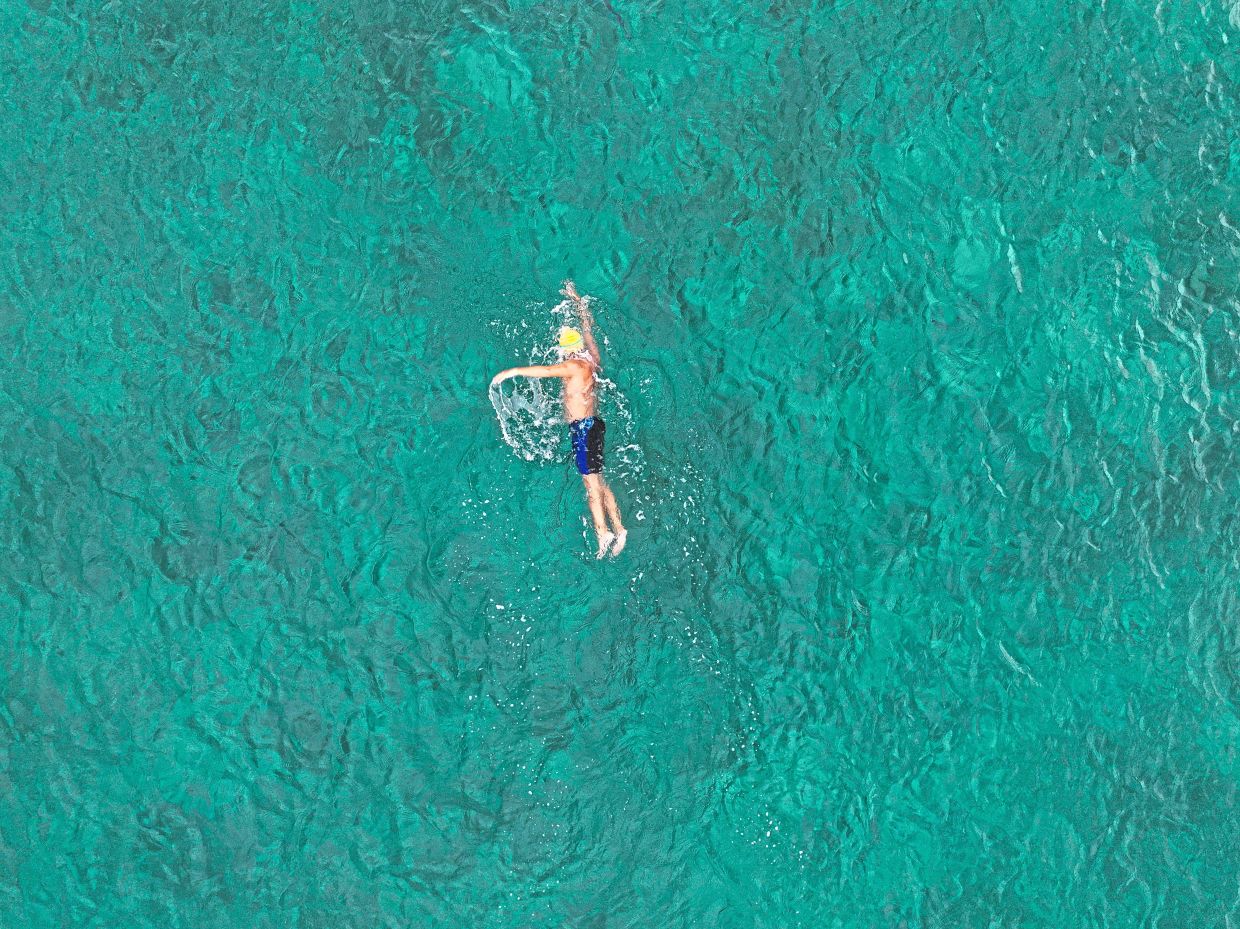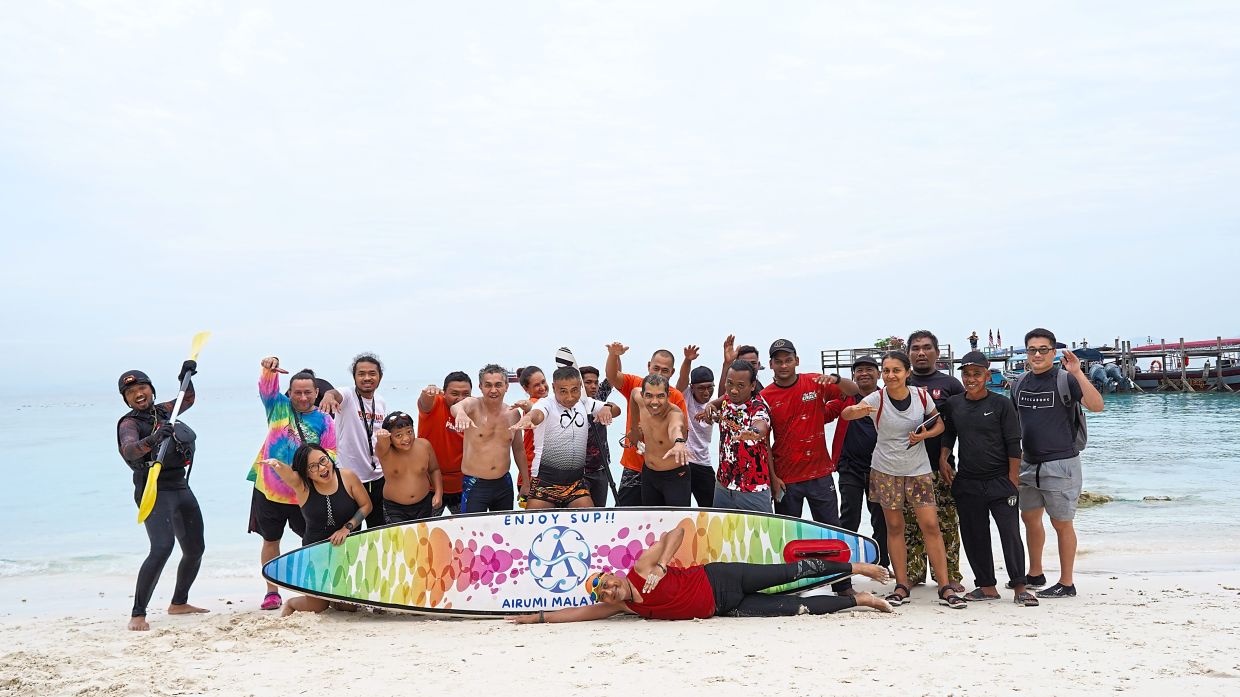Ridzwan feeling on top of the world during his first swim from Perhentian to the Terengganu mainland in March 2021. Photos: Ariff Budiman Abdul Halim & Muhamad Aqil Azfar Khalili
Despite the gruelling situations of a marathon swim – over 10km in open water, uncertain weather conditions, and unaided by any flotation devices – the biggest challenge is mostly mental.
“It’s all in the mind,” says Ridzwan Rahim, the first Malaysian marathon swimmer and the only one so far to swim across the four channels connecting the Terengganu mainland and the three islands of Perhentian, Lang Tengah and Redang.
Known as the Wonderful Terengganu Four Swims – or the WTF Swims – they comprised a total distance of 70km and were completed in March 2021, June 2023, March 2024 and July 2024.
“If you train properly and follow a two to three month programme, your body will be conditioned for the long swim and less likely to feel soreness or pain.
“But mentally, the mind sometimes plays tricks on you, especially if it’s during the daytime. When you look around, all you see is water and land seems very far away and doesn’t get nearer no matter how much you swim. Then, you feel like giving up, even when there aren’t any issues physically – your body, breathing, heart rate and pace are alright,” says the 47-year-old former journalist- turned-entrepreneur who only learnt to swim at the age of 32.
It’s for this reason that Ridzwan prefers to swim at night.
“There are fewer distractions – all you see is the guide (kayaker with light). It’s peaceful, cooler and also more beautiful,” he says, likening it to being in outer space.
“There’s a phenomenon known as bioluminescence where the movement of marine creatures and organisms emits a bluish light which makes the experience magical and out of this world,” he enthuses.
It all started with Ridzwan’s first swim from Perhentian to Besut, Terengganu on the mainland in 2021, which he calls “the Easy One”.
“Inspired by the English Channel in Britain and Rottnest Channel in Australia, I called the 17km route the Perhentian Channel.
“It was an easy one because the weather was perfect, the sea calm, and the wind blew in our favour. The only challenge was minor currents at the end of the swim,” says Ridzwan, who took eight hours 56 minutes and 30 seconds to complete it.
“After the first swim, I looked at the map and discovered that the distances between the three islands and mainland were suitable for marathon swimming, and that’s how from one, it became four swims, on average one per year.
“I chose the East Coast because the water is beautiful, and it’s good for scuba diving and snorkelling. At times, the water is so clear, you can see the bottom of the ocean while swimming. Also, the sea in Malaysia is warm and many visitors from overseas really enjoy this because they don’t need to brave the cold or wear a wetsuit,” he says.
The following year (2022), he attempted the second swim – “the Failed One” – of the Redang Channel from Redang to Penarik, Terengganu on the mainland.
“We had to attempt this one twice before succeeding. The first attempt failed due to inexperience because with the previous easy one at Perhentian, we took things for granted.
“The sea was very choppy and I was swimming against the currents. I suffered from cramps and had to give up after 15 hours with just 6km more to go,” he shares.
But Ridzwan tried again in June 2023 and succeeded.
Known as “the Brutal One”, Ridzwan completed the 25km route in 20 hours 42 minutes and 26 seconds despite swimming under brutal conditions with choppy waters for about 20km.
“We were more mentally prepared to face the challenge. It’s crucial to find your rhythm. As long as you can breathe comfortably, there’s oxygen going to the brain, you can think, and you can go on.
“But if the water is very choppy and you can’t find a breathing pattern, it can cause you to become anxious and tire easily,” he says.
The third swim, called “the Monsoon One” from Lang Tengah to Perhentian, was the hardest.
Ridzwan says weather conditions are another challenge marathon swimmers face.
“We’re swimming in open water so it’s at the mercy of Mother Nature. For the third swim, because of misplanning, I ended up swimming during the monsoon. Even though it was March and the monsoon was supposed to have ended, when we got there, it was still very much monsoon season.
“The sea was rough, with swells of around two metres – higher than the ceiling – and it wasn’t just difficult for me, but my crew too. Many of them were seasick but when they saw I’d found my rhythm, they didn’t tell me about it until much later because they wanted me to go on.”
Ridzwan refers to the fourth swim – a 10km one from Redang to Lang Tengah which he completed in July this year – as “the Final One” and says it was “a happy ending” because everything went well and according to plan.
But Ridzwan admits he is far from the end because not only does he intend to take on new routes internationally, he also wants to help others achieve their marathon or channel swim dreams in Malaysia.
The WTF Swims project is self-funded and besides Ridzwan, the team consists of seven volunteers – two observers, one team leader, a feeder, a photographer, a videographer and a kayaker – who all have full-time jobs.
“Precision is priority in a marathon swim, so we plan, execute and document it, keeping a log of all the swims.”
Although he is an avid marathon swimmer now, Ridzwan reveals that initially, he had a fear of water.
“When my feet can’t touch the bottom of the pool or sea, I would panic,” he shares. “I was learning scuba diving but my instructor, Dolphin Lee, encouraged me to learn to swim before getting certified as a diver, because the skillsets are very different, and both are important.
“He offered to teach me, and after two months, I learnt the freestyle,” says Ridzwan who is now also a certified rescue diver.
Ridzwan was already swimming regularly with his squad so it wasn’t his first marathon swim when he started the WTF project.
He has previously done a 10km marathon swim in Thailand, a 16km round-island swim in Perhentian, and a day-to-night-one during the 40-50km Malacca Straits Swim.
“Because of this, I was prepared – I could swim marathons, whether during the day or night, and my diving experience has made me comfortable in the sea.”
But he admits that preparation is still required.
“Before each marathon, there’s swim training which takes two to three months. We increase the distance progressively from 5km to the actual swim length. This happens thrice weekly at a pool, with longer swims on weekends.”
While some advocate a strict training regime with proper diet and nutrition, lots of sleep and exercise, Ridzwan is a proponent of a more sustainable approach.
“As a working adult, I can’t change my lifestyle, except for doing longer swims on Sundays. My focus is on getting a better posture. If you can get into a proper horizontal position in the water, it helps a lot because there’s less drag and the swim will be smoother.”
Mealtimes are a vital part of a marathon swim, he adds.
“We’d pause for feeding every 45 minutes. I’d tread water and eat and drink,” he says, adding that he’d usually have bananas, apples, energy bars, isotonic drinks, coffee and/or water.
“My teammate would tie the bottle or container containing the food and drink to a rope and throw it to me. After I finish, they’d pull back the rope.
“When the water is calm, it’s easy to feed. I can lie flat on my back like a sea otter that puts its food on its chest and feeds,” he says.
“But when the sea choppy, it’s more difficult because I’ve to prevent the sea water from getting into the food and drinks or it’ll taste salty,” he adds.
It’s having such knowledge as well as the experience of going through marathon and channel swims that makes Ridzwan desire to help other marathon swimmers achieve their dream.
“We’re excited to have people do these swims in Malaysia, especially to bring people from overseas for marathon swims in Malaysia.”
In September, two Australian swimmers engaged Ridzwan’s team for their swim from the Terengganu mainland to Perhentian in the Downunder Duo Swim 2024 project.
It took them seven hours and 11 minutes to complete the 17km swim.
Ridzwan’s future plans include swimming internationally in South Africa, an 8km swim from Robert Island to Capetown, which isn’t a marathon swim but a personal challenge.
“The water’s very cold, between 10°-13°C – different from in Malaysia – and I wanted to see if I could do it,” he says.
He also intends to take on the Rottnest Channel in Australia and the San Francisco marathon swim in the US.
Besides swimming, Ridzwan also enjoys marathon running and stand-up paddle boarding.
But for now, he says he’ll be busy helping people to do marathon and channel swims in Malaysia.
“I hope to help develop water and sports tourism in Terengganu and other parts of Malaysia.”
Ridzwan reveals that he didn’t embark on his project for fame but rather to show people what’s possible.
“In open water swims such as triathlons, swimmers use floats tethered to their waists.
“It makes people feel safer but an over-reliance on flotation devices is risky because what if they burst or leak?
“What we’re doing are unassisted swims – when in the water, the swimmer doesn’t touch anyone or anything, so they learn to be independent.
“They’ve to learn about water survival skills and safety, such as treading water, floating on their backs, and how to swim long distances.
“This is good for them in the long run,” he concludes.
Go to WTF Swims for more info.





















